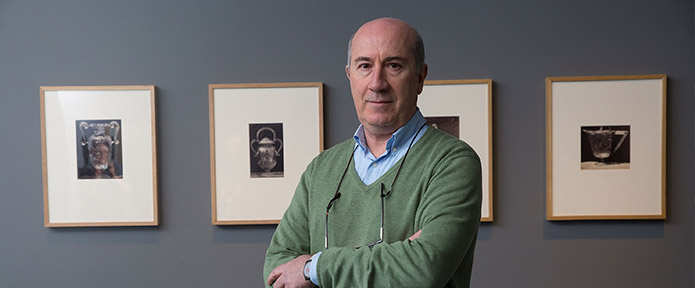20191023_MUN_ExhibitionJaneCliffordTheTreasureOfTheDolphin
The MUN opens the exhibition 'Jane Clifford. The Treasure of the Dolphin', a pioneering project made by a woman in 19th century Spain.
The sample collects 54 photographs of the works that make up the Treasure of the Dauphin, taken by Jane Clifford, the first woman to join the French Society of Photography.

The University Museum of Navarra opens Jane Clifford. The Treasure of the Dolphina sample that brings together 58 historical photographs from the 19th century of the works that make up The Treasure of the Dolphin, a collection of rock crystal, gold, enamel and precious stone objects housed at the Museo del Prado. The photographs were acquired by the Museo Universidad de Navarra in 2011 and 2018 and are presented in this first monographicexhibition by British photographer Jane Clifford. Its curator, Mario Fernández, has stressed that these photographs "belong to the most extensive project of documentation of works of art made by a woman in Spain in the 19th century". In addition, research has revealed that Jane Clifford was the first woman admitted to the French Photographic Society in 1856.
In the presentation of the sample has been accompanied by Rafael Levenfeld, director artistic Museum, who stressed that this project is part of the research vocation of the center, "a central and essential element that is always present. He also highlighted the uniqueness of these pieces, because "photography had been presented in 1839 with still very crude elements and here we can see these images made in 1863, which were high-tech objects for the time".
The photographic project made by the author, explains the curator, was born from the need that arose in the 19th century to document works of art as a way to disseminate them. "The project is triggered because Sir John Charles Robinson, curator of London's South Kensington Museum, today's Victoria & Albert, wants to get images of relevant works of art. He first gathered the photographs from the sister collection of the Dauphin Treasure held at the Louvre. To complete this, he commissioned those of the Dauphin Treasure held at the Prado Museum and it is Jane Clifford who is carrying it out." Jane had just been left at position of the studio of her recently deceased husband, the renowned photographer Charles Clifford, established in Madrid since 1850.
To carry out the assignment, the photographer had to face different challenges, derived from the state of development of photography at the time. "Technically, they are complicated. The wet collodion technique required emulsifying the negative at the time and with the collodion still wet, taking the photograph, taking it out quickly and fixing the negative before it dried," she explains. Fernández.
To achieve the necessary light, he even had to take some pieces outside when photographing them, as revealed by the harsh shadows that can be seen in some of them or the reflections of the street in others. In addition, she points out that "the copies of the photographs were made to be sold by subscription and the production was extensive". Despite being the author of the images, they are not signed, but she used the commercial stamp on her husband.
At the same time, Jane Clifford participated in editorial projects for the dissemination of monuments and works of art in Spain. "There is a very important project of dissemination of Spanish heritage that begins in the mid 1850s until the 80s, where the images of that heritage that you want to disseminate are engravings, lithographs... The first quality project that includes photographs is also carried out by Jane Clifford, using the photographs that her husband had made, for example, in the travels of Isabel II".
As a complement to Jane Clifford's work, four photographs by Jean Laurent, who fifteen years later, in 1878, carried out another project documentation of the Treasure, are gathered at exhibition . They show the evolution of the photographic technique in that period.

